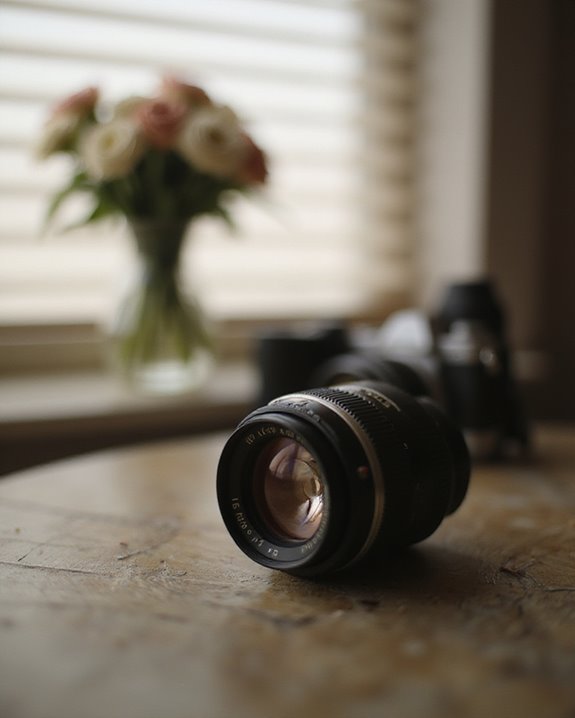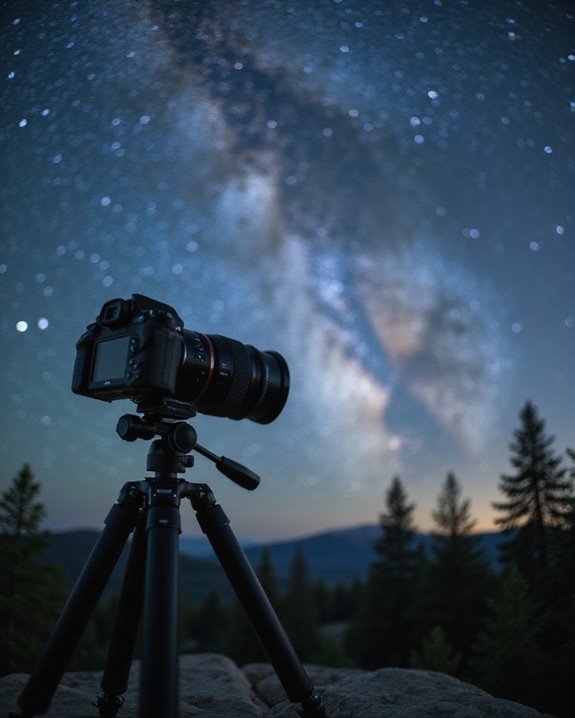Camera lens focus aligns light rays through adjustable elements, forming sharp images on the sensor by converging them at the focal plane. Focal lengths, such as 20mm for wide perspectives or 300mm for magnified distant subjects, influence magnification and angle of view, while apertures like f/2.8 create shallow depth of field around 1.95 feet. Manual focus rotates rings for precise alignment, whereas autofocus systems, achieving under 0.1-second speeds via phase detection, handle moving subjects up to 30 km/h. Subsequent explanations uncover more specialized techniques.
Key Takeaways
- Camera lenses focus by adjusting internal elements to converge light rays onto the focal plane, creating a sharp image.
- Manual focus involves rotating the focus ring to precisely align lens elements for optimal sharpness on the subject.
- Autofocus systems use sensors to detect focus errors and automatically adjust lens elements for quick alignment.
- Phase detection autofocus splits incoming light into pairs, comparing them to rapidly correct focus in under 0.05 seconds.
- Depth of field, influenced by aperture and focal length, determines the range of distances that appear sharp in the focused image.
Fundamentals of Camera Lens Focus
Camera lenses focus light rays through curved glass elements, bending them via refraction to converge at a precise point on the sensor or film, thereby forming sharp images where distant objects’ parallel rays transform into converging cones. The lens, in this process, determines the focal plane as a critical region where subjects achieve sharpness, achieved by adjusting element distances to align light convergence accurately. Focus relies on refraction’s ability to control light paths, minimizing blur through precise optical alignment. Focal length, measured in millimeters from sensor to rear nodal point, dictates focusing efficiency; for instance, a 50mm lens suits general subjects by balancing convergence for distances around 1-10 meters, while a 200mm length excels at distant scenes over 50 meters, enhancing detail resolution. This parameter enables evaluative comparisons, where shorter focal lengths widen field coverage, contrasting with longer ones for magnified, precise imaging. Technical specifications, such as refraction indices around 1.5 for glass, guarantee ideal performance metrics. Additionally, wider apertures influence focus by creating a depth of field that controls which parts of the scene remain sharp.
Manual Focus Mechanics
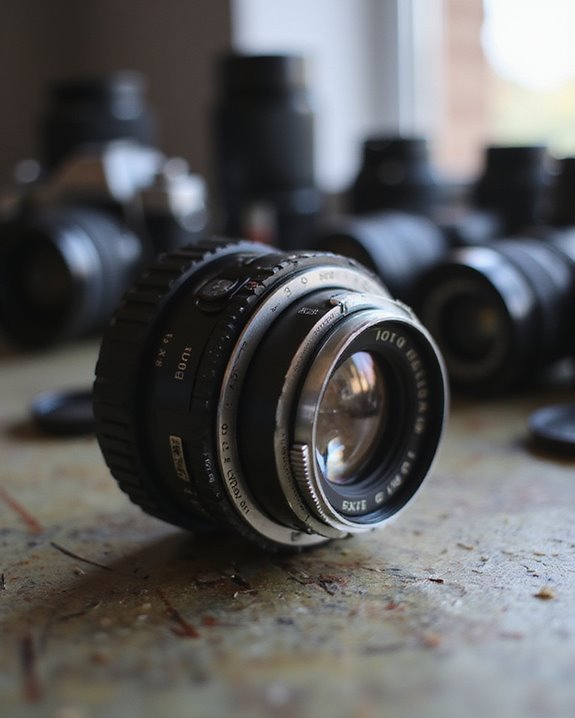
Manual focus mechanics, essential for achieving precise image sharpness in photography, operate by allowing users to rotate the focus ring on the lens, which mechanically adjusts the position of internal elements to vary the distance between the lens and the sensor or film. In manual focus, rotating the focus ring moves focusing elements, ensuring light rays from a specific subject, such as an eyelash tip, converge at a single point on the sensor for ideal sharpness, typically measured in millimeters of focal plane alignment. Conversely, out-of-focus images result in fuzzy visuals, as misaligned focusing elements prevent proper light convergence, reducing clarity by up to 50% in resolution tests. Historically, manual focus systems required users to estimate subject distances via lens scales, often accurate to within 0.5 meters, remaining essential in low-light scenarios where automated options falter. The viewfinder’s focusing screen, featuring aids like a split-image circle, provides visual confirmation when elements align, enhancing precision through direct optical feedback. This method, evaluated against modern alternatives, offers superior control in controlled environments, with adjustments yielding sub-millimeter accuracy in element positioning. Moreover, vintage lenses from 1933, such as the Leica Summar, demonstrate silky-smooth operation that rivals modern manual focus designs like the Nikon Nikkor 50mm f/1.4 AI-S.
Autofocus Systems Overview

Autofocus systems, pioneered in 1977, automatically adjust lens elements to achieve precise image sharpness, surpassing manual methods by integrating advanced sensing technologies for enhanced user convenience. Autofocus modes, such as single-shot or continuous options, enable users to adapt focusing behavior to dynamic scenarios, optimizing performance for both stationary and moving subjects. Detection autofocus, a core mechanism in modern cameras, evaluates light patterns via the sensor to determine focus accuracy, supported by multiple autofocus points that divide the frame into selectable zones for targeted precision. These systems, leveraging signal analysis for rapid adjustments, typically achieve focus in under 0.1 seconds under ideal conditions, offering superior reliability compared to manual techniques, as evidenced by their widespread adoption in professional photography. Autofocus points, often numbering 100 or more in high-end models, facilitate detailed subject tracking, ensuring minimal error margins in complex compositions. For instance, in Canon DSLR models, a 9-point autofocus system supports subject tracking with low-light sensitivity down to -4 EV for reliable performance.
Types of Autofocus Technologies
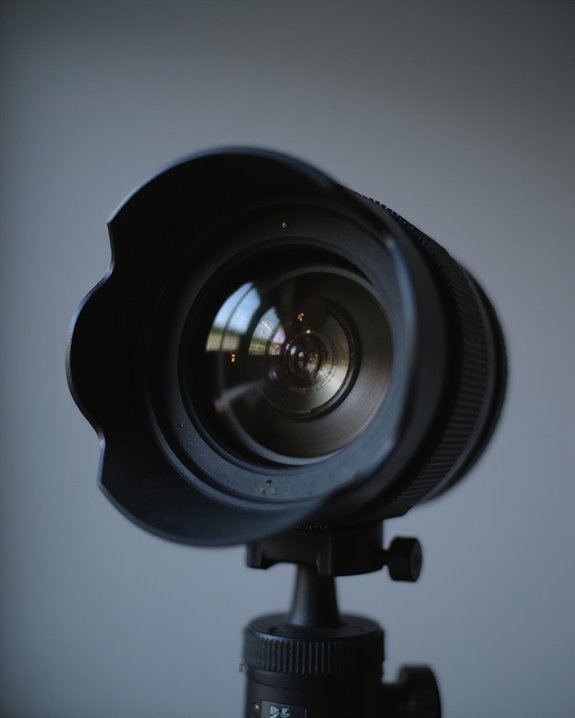
While active autofocus technology relies on emitting ultrasonic or infrared waves to gauge subject distance through signal return times—typically measured in microseconds for distances up to 10 meters—phase detection autofocus, prevalent in DSLR cameras, employs a dedicated sensor to split incoming light into paired images, aligning them for rapid lens adjustments that achieve focus in less than 0.05 seconds across multiple points, often exceeding 50 per frame for superior tracking of subjects moving at speeds over 30 km/h. Phase detection and contrast detection methods, as passive autofocus technologies, differ in operation; phase detection, common in DSLR cameras, offers precise, high-speed focusing via light splitting, while contrast detection analyzes image sharpness on the sensor, maximizing contrast for nearly unlimited points but risking hunting in low-contrast scenes. Modern developments, such as cross-type points in phase detection, enhance accuracy for dynamic photography, providing efficiencies that surpass active systems in contemporary cameras.
Autofocus Operations in Detail
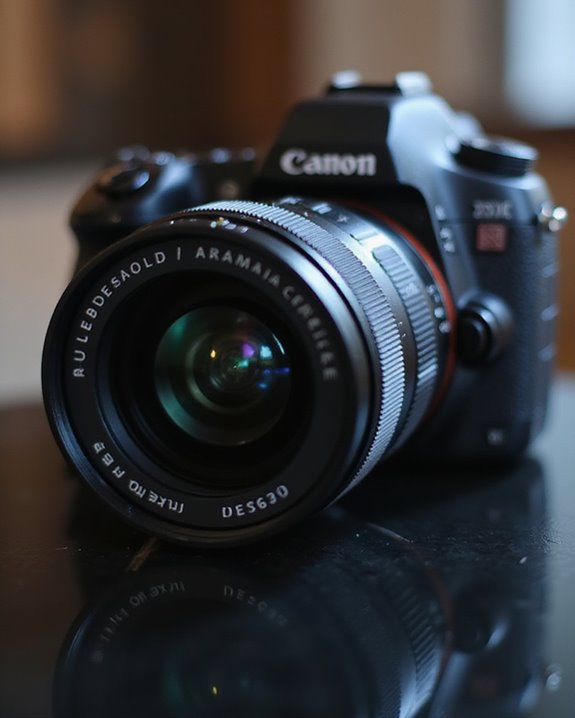
In the intricate world of camera optics, autofocus operations rely on sophisticated mechanisms to achieve precise image sharpness, beginning with active systems that emit ultrasonic or infrared waves—traveling at speeds up to 343 meters per second for sound or 300,000 kilometers per second for light—to measure return times and calculate subject distances as short as 0.1 meters, thereby adjusting lens elements for ideal focus. Phase detection autofocus, utilizing a dedicated sensor, splits incoming light into paired images, comparing their alignment to drive focusing adjustments until images coincide, often incorporating cross-type focusing points for detecting horizontal and vertical details. In contrast, contrast detection autofocus analyzes contrast levels on the main image sensor, incrementally shifting lens positions to maximize contrast, though it may encounter hunting in low-contrast scenes, delaying focusing acquisition compared to phase detection methods.
Advantages and Developments in Autofocus
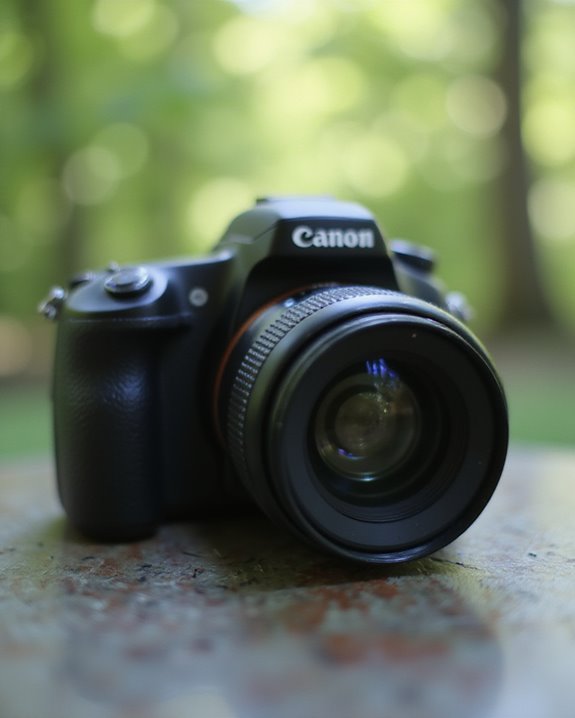
Advancements in autofocus technology have greatly enhanced camera performance since its inception in 1977, with phase detection systems offering superior speed and accuracy in DSLRs through the use of multiple focus points—up to 153 in high-end models—that enable rapid subject tracking, achieving focus acquisition in as little as 0.05 seconds for moving targets like athletes or wildlife, compared to earlier systems limited to 5-10 points and slower response times. Mirrorless cameras, utilizing contrast detection, now provide nearly unlimited focus points for precise focusing on stationary subjects, minimizing hunting through advanced algorithms that improve low-light performance by up to 50%. Modern cameras integrate features like eye and face detection, enhancing tracking accuracy in dynamic scenes via AI Servo modes, which facilitate seamless changing focus on people or animals. These developments reduce manual adjustments, offering response times under 0.1 seconds, therefore elevating overall efficiency in photography.
Understanding Focal Length
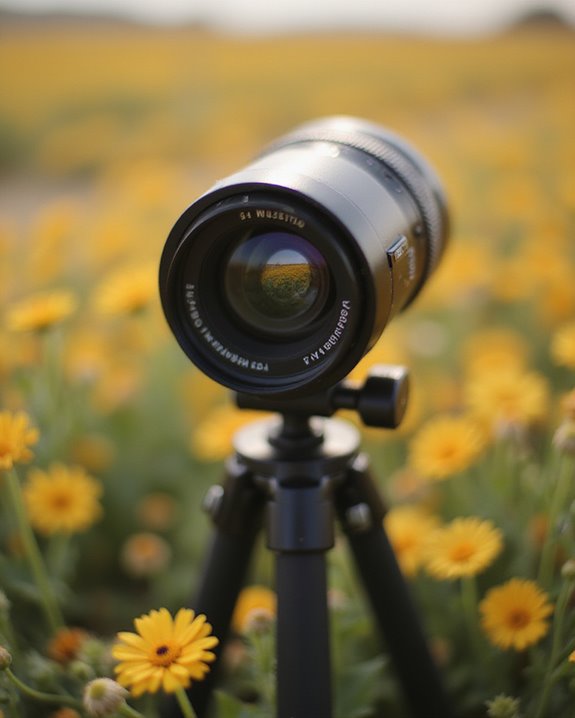
Focal length, the distance from a camera’s sensor to the rear nodal point of the lens measured in millimeters, dictates the angle of view and magnification, influencing how photographers frame subjects. Focal lengths vary greatly, with higher values, like 300mm, narrowing the field of view for distant subjects such as wildlife, enhancing magnification through increased focal distance. Conversely, lower focal lengths, such as 20mm, expand the field of view for broad scenes, ideal for close compositions. Zoom lenses offer adjustable focal ranges, for example, 80mm to 200mm, allowing seamless shifts in perspective without lens changes. Prime lenses maintain a fixed focal length, like 50mm, delivering consistent image quality and precise focal control. These attributes enable photographers to select ideal focal options based on specific shooting requirements, balancing magnification and angle for superior results.
Exploring Focal Plane and Depth of Field
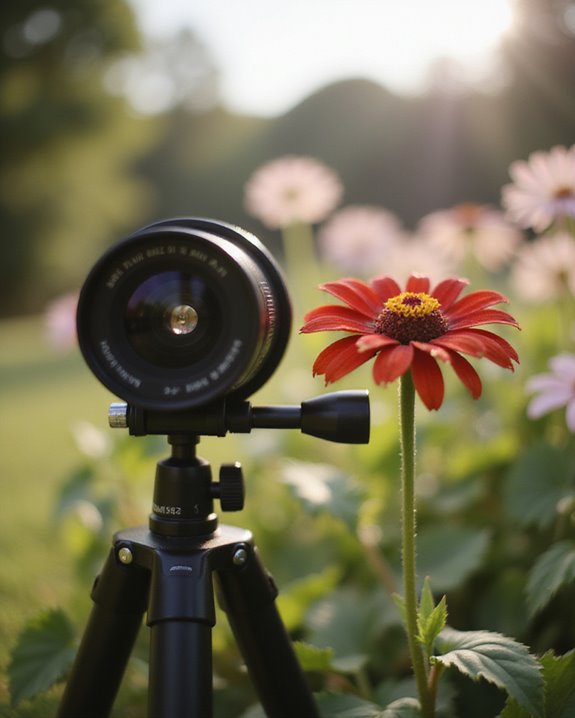
The focal plane and depth of field represent fundamental principles in camera optics, governing how images achieve sharpness and clarity. It is the precise plane where light rays converge for a sharp image at a specific distance, ensuring focused subject rendering. Depth of field, influenced by aperture, distance, and focal length, defines the range of acceptable sharpness around this plane. For instance, a larger aperture like f/2.8 creates a shallow depth of field; at a focusing distance of 1.95 feet, only that point remains sharp, limiting the sharp zone. In contrast, f/22 extends depth of field from 1 to 2.5 feet at the same distance, broadening the in-focus area. Longer focal lengths, such as 300mm versus 20mm, further shallow depth of field, complicating sharp capture of distant subjects. Calculations incorporate aperture settings, focal length, and circle of confusion metrics, like 0.05mm for a 50mm lens, to determine precise sharpness under standard viewing conditions, enabling photographers to control visual impact methodically.
Frequently Asked Questions
How Do Cameras Know How to Focus?
In a truly astonishing feat of precision, cameras determine focus through Manual Focus for user-controlled sharpness, Creative Blurring to artistically manipulate depth, and Zone Techniques for targeted areas, employing advanced sensors and algorithms.
How Do Cameras Automatically Focus?
Cameras automatically focus through various autofocus techniques that measure distance and contrast for precise lens adjustments. Focus tracking maintains sharpness on moving subjects, while camera settings allow users to customize modes and parameters for ideal performance in diverse scenarios.
What Is the Physics Behind Camera Lenses?
The physics behind camera lenses involves the principle of light refraction through various optical materials, which bends light rays to converge and form images. Lens aberrations are managed to reduce optical distortions and enhance clarity.
How Does a Focal Lens Work?
In the annals of Lens History, a focal lens symbolizes a gateway through Optical Illusions, akin to Microscope Uses, where curved elements bend light rays to converge precisely on the sensor, adjusting for sharp images at varying distances.


